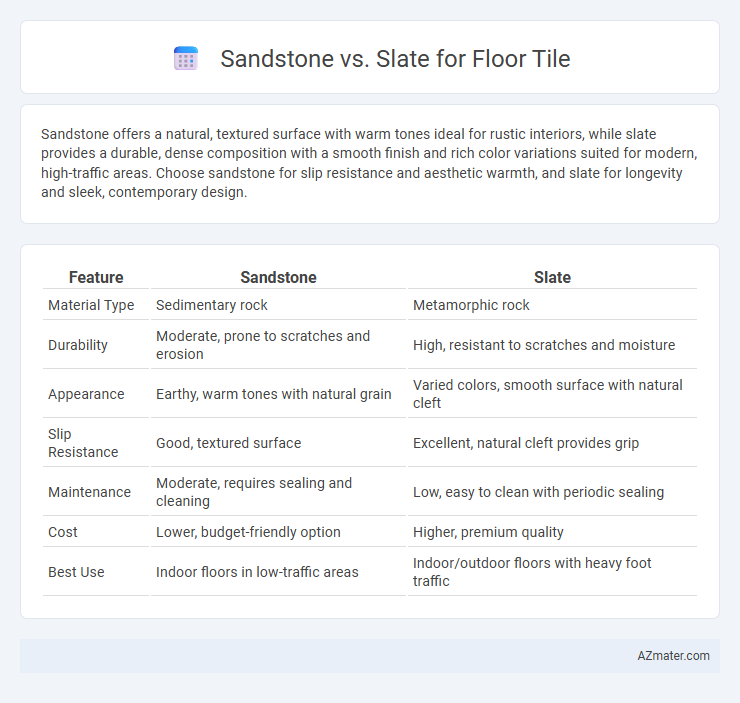Sandstone offers a natural, textured surface with warm tones ideal for rustic interiors, while slate provides a durable, dense composition with a smooth finish and rich color variations suited for modern, high-traffic areas. Choose sandstone for slip resistance and aesthetic warmth, and slate for longevity and sleek, contemporary design.
Table of Comparison
| Feature | Sandstone | Slate |
|---|---|---|
| Material Type | Sedimentary rock | Metamorphic rock |
| Durability | Moderate, prone to scratches and erosion | High, resistant to scratches and moisture |
| Appearance | Earthy, warm tones with natural grain | Varied colors, smooth surface with natural cleft |
| Slip Resistance | Good, textured surface | Excellent, natural cleft provides grip |
| Maintenance | Moderate, requires sealing and cleaning | Low, easy to clean with periodic sealing |
| Cost | Lower, budget-friendly option | Higher, premium quality |
| Best Use | Indoor floors in low-traffic areas | Indoor/outdoor floors with heavy foot traffic |
Introduction to Sandstone and Slate Floor Tiles
Sandstone floor tiles offer a naturally textured surface with warm earthy tones, making them ideal for creating rustic or Mediterranean-style interiors. Slate tiles provide a durable, dense, and fine-grained option with a range of colors from gray to green and black, known for their slip resistance and suitability in high-traffic areas. Both materials are sedimentary rocks frequently used for flooring, but sandstone tends to be softer and more porous compared to the harder, more durable slate.
Key Differences Between Sandstone and Slate
Sandstone floor tiles feature a granular, porous texture derived from compacted sand particles, offering a warm, natural appearance, whereas slate tiles are dense, fine-grained metamorphic rocks with a smooth, layered structure that provides a sleek, modern look. Sandstone's softness makes it more prone to scratching and requires sealing to prevent staining, while slate is more durable, resistant to moisture, and does not need frequent sealing. The color palette of sandstone includes earthy tones like beige and tan, contrasted by slate's darker hues such as gray, black, and green, influencing their suitability for different interior design styles.
Appearance and Aesthetic Appeal
Sandstone floor tiles offer a warm, natural look with earthy tones and a grainy texture that enhances rustic and traditional interiors. Slate tiles provide a sleek, sophisticated appearance with rich, deep color variations and a smooth, slightly flaky surface that complements modern and contemporary designs. Both materials add unique character but differ significantly in visual impact and style suitability.
Durability and Strength Comparison
Sandstone offers moderate durability with a Mohs hardness of 6-7, making it suitable for low to medium traffic areas but prone to scratching and erosion over time. Slate, with a higher hardness rating of 6-7 and dense, fine-grained structure, exhibits superior strength and resistance to chips and cracks, ideal for high-traffic floors. Slate's natural cleft surface also provides enhanced slip resistance, contributing to its longevity in flooring applications compared to the more porous and softer sandstone.
Slip Resistance and Surface Texture
Sandstone floor tiles offer a naturally rough texture providing excellent slip resistance, making them suitable for areas prone to moisture. Slate tiles feature a more varied surface texture with natural clefts that enhance grip but can vary in smoothness depending on the finish. Both materials provide durable options, but sandstone generally outperforms slate in consistent non-slip properties due to its granular surface structure.
Maintenance and Cleaning Requirements
Sandstone floor tiles demand regular sealing to prevent staining and require gentle cleaning with pH-neutral detergents to avoid surface damage. Slate tiles are more durable and naturally resistant to moisture and stains but still benefit from periodic sealing to protect against dirt buildup and maintain their appearance. Routine sweeping and damp mopping suffice for both materials, with harsh chemicals avoided to preserve tile integrity.
Installation Process and Costs
Sandstone floor tiles require professional installation to handle their porous nature and ensure proper sealing, which helps prevent staining and water damage; this process can be time-intensive and moderately costly. Slate tiles are denser and less porous, making installation slightly less demanding, though their uneven surface often requires more precise leveling and grout work, increasing labor expenses. Overall, sandstone installation tends to incur higher costs due to sealing and maintenance requirements, while slate's durability can reduce long-term expenses despite potentially higher initial labor fees.
Indoor vs Outdoor Suitability
Sandstone offers excellent durability and natural slip resistance, making it ideal for outdoor floor tiles in patios and garden paths but may require sealing to prevent staining indoors. Slate provides a denser, harder surface with superior moisture resistance, making it highly suitable for indoor flooring in kitchens and bathrooms while also performing well outdoors due to its weather-resistant properties. Both materials offer unique aesthetic and functional advantages, with sandstone favored for rustic outdoor settings and slate preferred for sleek indoor designs requiring longevity and ease of maintenance.
Environmental Impact and Sustainability
Sandstone floor tiles are naturally abundant and require minimal processing, resulting in a lower carbon footprint compared to slate, which often involves more energy-intensive quarrying and finishing procedures. Sandstone's porosity allows for better biodegradability and less chemical treatment, enhancing its sustainability credentials over denser, less permeable slate. Both materials are durable and recyclable, but sandstone's generally lower environmental impact makes it a preferable choice for eco-conscious flooring solutions.
Choosing the Right Stone Tile for Your Space
Sandstone offers a warm, natural look with its earthy tones and textured surface, making it ideal for creating a cozy, rustic atmosphere in living areas or patios. Slate provides a sleek, durable option featuring dark, rich colors and a smooth finish, perfect for high-traffic spaces like kitchens and bathrooms due to its resistance to moisture and wear. Selecting between sandstone and slate depends on the desired aesthetic, durability needs, and maintenance preferences for your specific floor tile project.

Infographic: Sandstone vs Slate for Floor Tile
 azmater.com
azmater.com